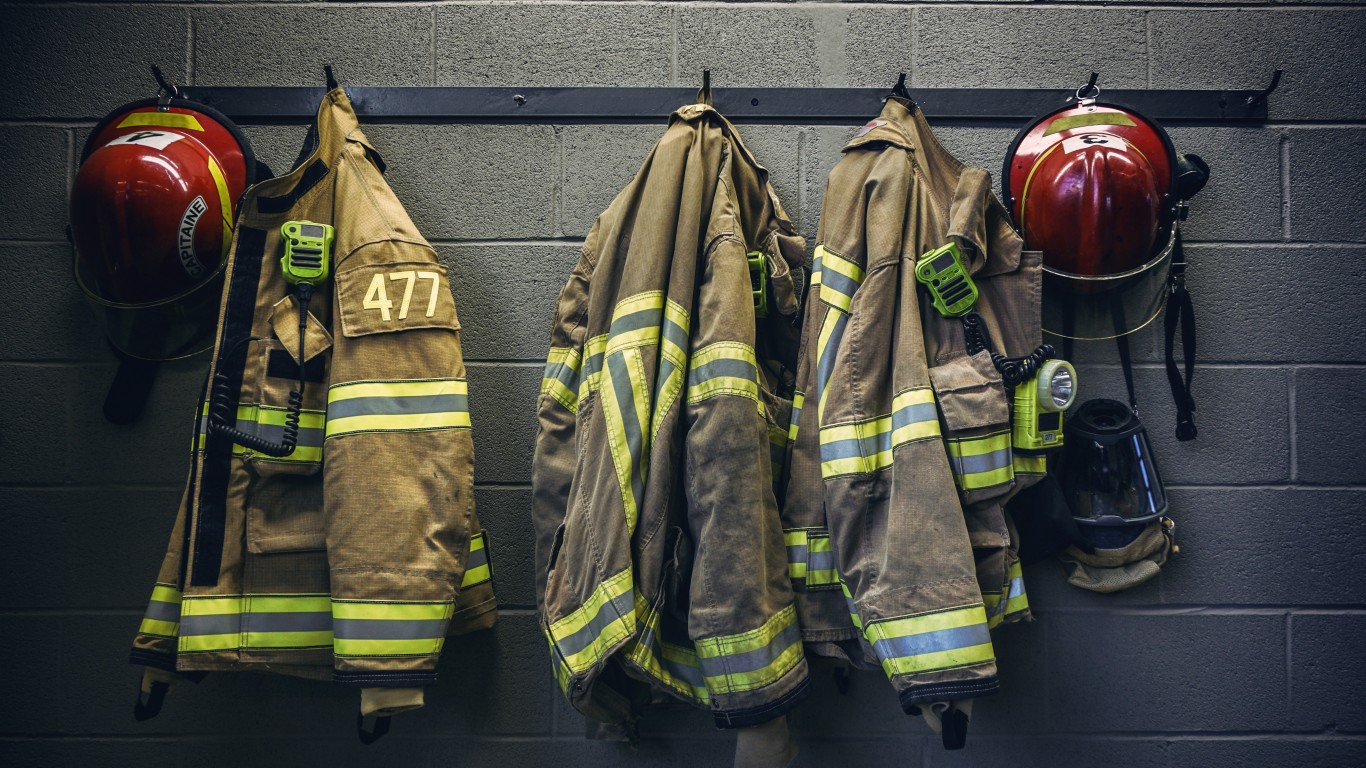
According to the U.S. Bureau of Labor Statistics, the fatal work injury rate for fallers — the frontline workers of the logging industry — last year was a staggering 530 per 100,000 workers, or 33 workers out of a total workforce of 5,600. Compare that to the national average for all occupations tracked by the U.S. Department of Labor of 3.3 deaths per 100,000 workers.
But fallers are just one part of the hazardous logging, forestry, and tree-trimming businesses in which tens of thousands of workers are doing some of the most dangerous work in America. (On the other hand, here are 10 jobs that make parenting manageable.)
To determine the most dangerous jobs in the U.S., 24/7 Wall St. reviewed the 2021 Census of Fatal Occupational Injuries from the BLS. Occupations are ranked according to the most annual fatal injuries per 100,000 workers. Employment data used to calculate fatalities and injuries per worker came from the BLS Employment Projections program for 2021. We excluded broad-categories of occupations and occupations with fewer than five reported fatalities in 2021.
Commercial divers, industrial fishers, and almost any type of blue-collar job in the country’s oil and gas fields are also high-risk occupations. The list also includes lower-pay jobs like taxi driver, tree pruner, and roofer, as well as jobs in other mechanical trades like farm equipment mechanic, power-line installer, and elevator repairers. (Also see, domestic workers hold the most jobs in these 12 states.)
Here are the most dangerous jobs in the U.S.
Click here to read our detailed methodology.

23. Crane and tower operators
> Fatal work injury rate (2021): 20.0 per 100,000
> Fatal work injuries (2021): 9
> Common cause of fatal injury: Contact with objects and equipment
> Non-fatal injuries (2020): 390 (864.7 per 100,000)
> Total employed (2021): 45,100
[in-text-ad]
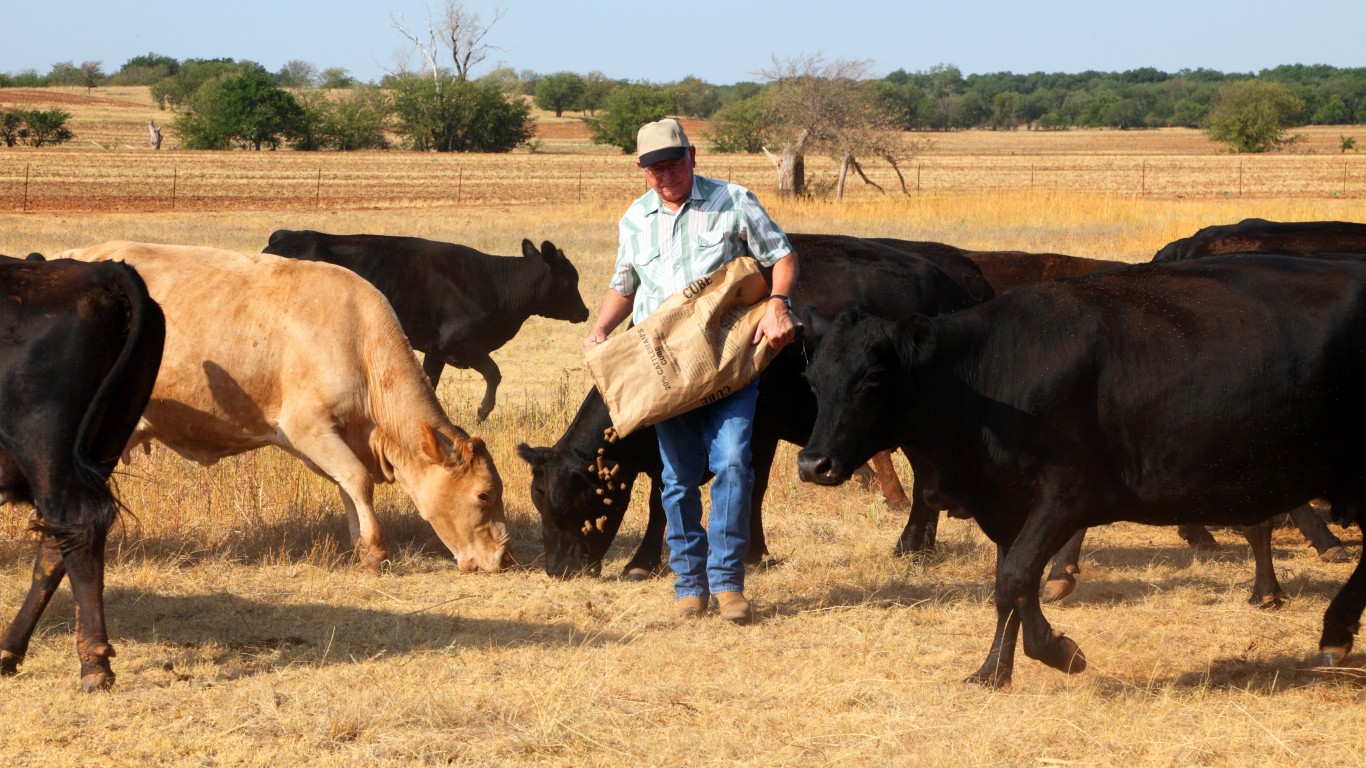
22. Farmworkers, farm, ranch, and aquacultural animals
> Fatal work injury rate (2021): 20.1 per 100,000
> Fatal work injuries (2021): 46
> Common cause of fatal injury: Transportation incidents
> Non-fatal injuries (2020): 4,950 (2,166.3 per 100,000)
> Total employed (2021): 228,500
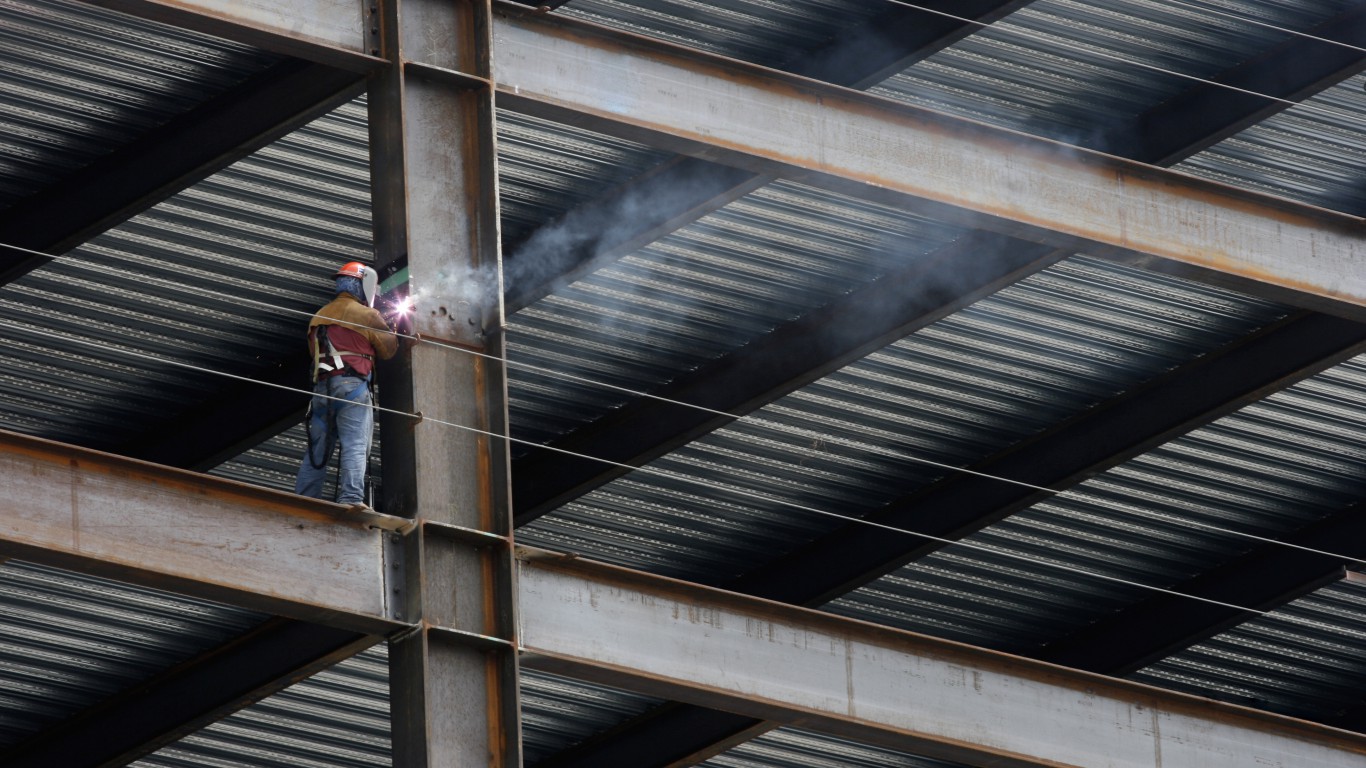
21. Structural iron and steel workers
> Fatal work injury rate (2021): 20.3 per 100,000
> Fatal work injuries (2021): 14
> Common cause of fatal injury: Falls, slips, trips
> Non-fatal injuries (2020): 780 (1,130.4 per 100,000)
> Total employed (2021): 69,000

20. Roustabouts, oil and gas
> Fatal work injury rate (2021): 21.4 per 100,000
> Fatal work injuries (2021): 8
> Common cause of fatal injury: Transportation incidents
> Non-fatal injuries (2020): 520 (1,394.1 per 100,000)
> Total employed (2021): 37,300
[in-text-ad-2]
19. Elevator and escalator installers and repairers
> Fatal work injury rate (2021): 21.6 per 100,000
> Fatal work injuries (2021): 5
> Common cause of fatal injury: Falls
> Non-fatal injuries (2020): 400 (1,724.1 per 100,000)
> Total employed (2021): 23,200
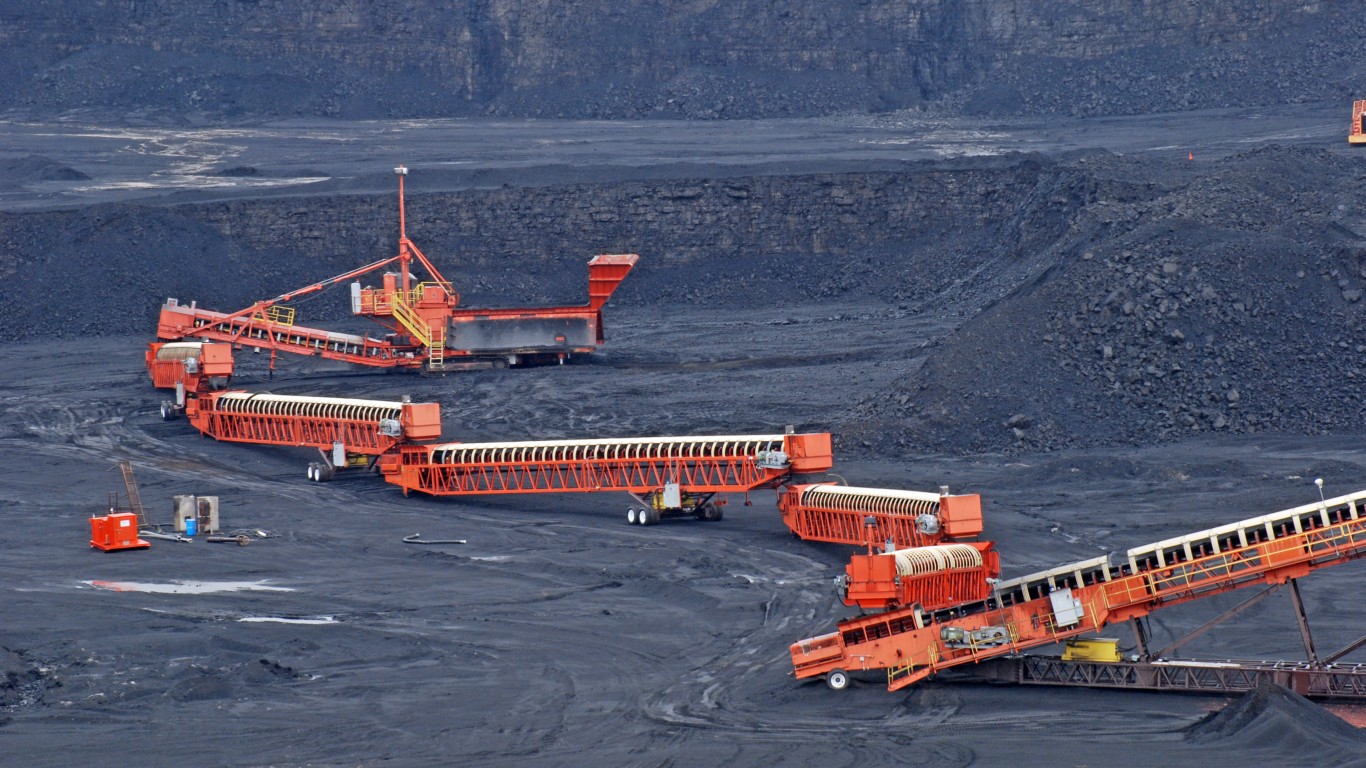
18. Excavating and loading machine and dragline operators, surface mining
> Fatal work injury rate (2021): 21.9 per 100,000
> Fatal work injuries (2021): 8
> Common cause of fatal injury: Contact with objects and equipment
> Non-fatal injuries (2020): 40 (109.6 per 100,000)
> Total employed (2021): 36,500
[in-text-ad]
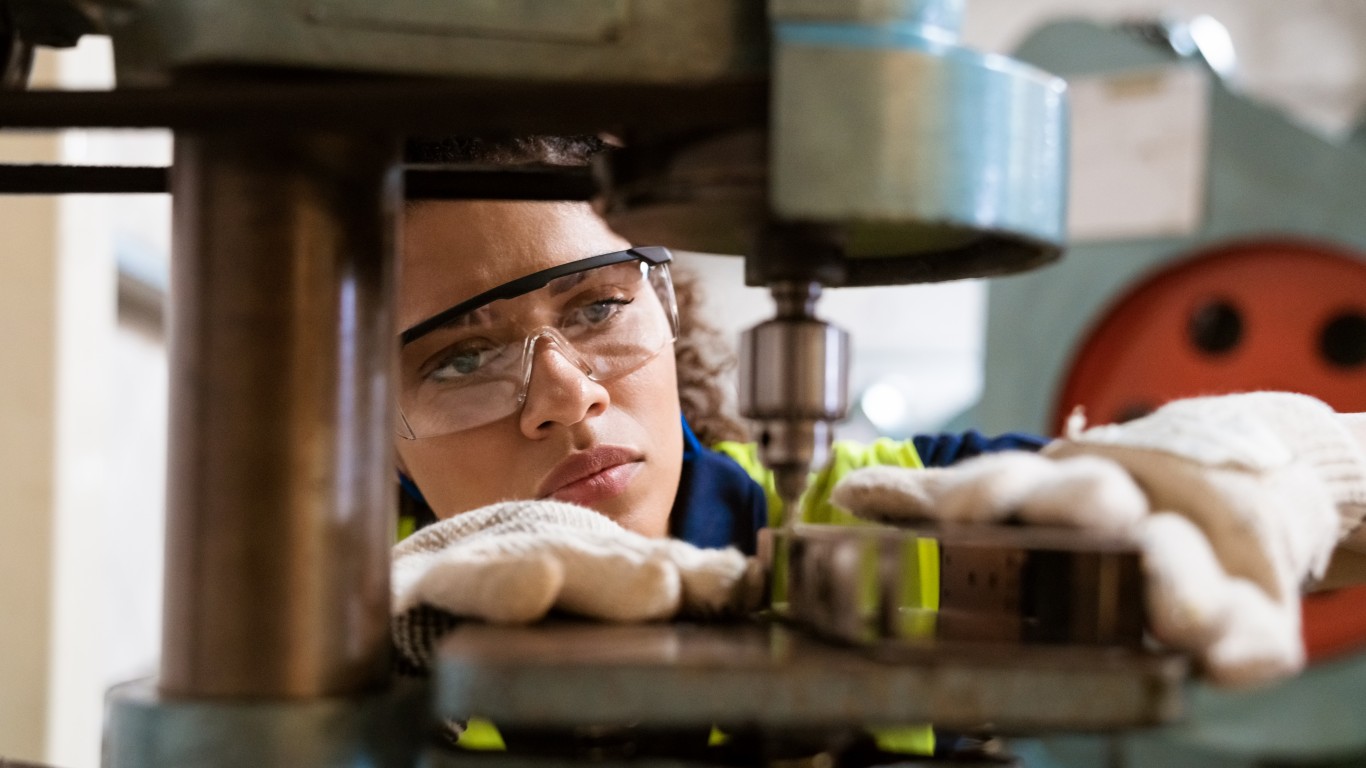
17. Maintenance workers, machinery
> Fatal work injury rate (2021): 22.2 per 100,000
> Fatal work injuries (2021): 13
> Common cause of fatal injury: Falls, slips, trips
> Non-fatal injuries (2020): 720 (1,230.8 per 100,000)
> Total employed (2021): 58,500

16. Audiovisual equipment installers and repairers
> Fatal work injury rate (2021): 22.6 per 100,000
> Fatal work injuries (2021): 6
> Common cause of fatal injury: N/A
> Non-fatal injuries (2020): 340 (1,278.2 per 100,000)
> Total employed (2021): 26,600

15. Taxi drivers
> Fatal work injury rate (2021): 23.3 per 100,000
> Fatal work injuries (2021): 30
> Common cause of fatal injury: Murder
> Non-fatal injuries (2020): 260 (202.3 per 100,000)
> Total employed (2021): 128,500
[in-text-ad-2]
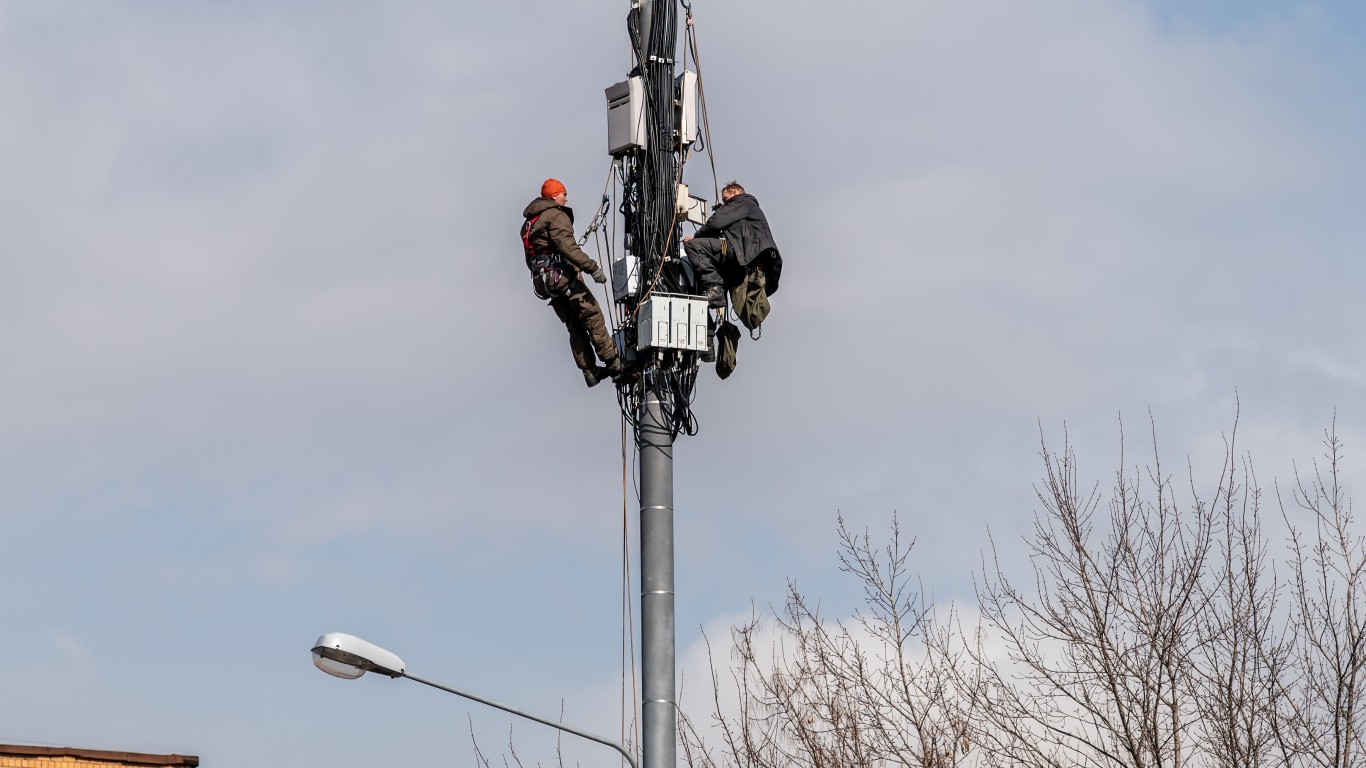
14. Electrical power-line installers and repairers
> Fatal work injury rate (2021): 23.7 per 100,000
> Fatal work injuries (2021): 30
> Common cause of fatal injury: Exposure to harmful substances or environments
> Non-fatal injuries (2020): 1,910 (1,508.7 per 100,000)
> Total employed (2021): 126,600

13. Wellhead pumpers
> Fatal work injury rate (2021): 27.8 per 100,000
> Fatal work injuries (2021): 5
> Common cause of fatal injury: Electrocution, explosion
> Non-fatal injuries (2020): 20 (111.1 per 100,000)
> Total employed (2021): 18,000
[in-text-ad]

12. Farm equipment mechanics and service technicians
> Fatal work injury rate (2021): 28.3 per 100,000
> Fatal work injuries (2021): 14
> Common cause of fatal injury: Contact with objects and equipment
> Non-fatal injuries (2020): 660 (1,333.3 per 100,000)
> Total employed (2021): 49,500
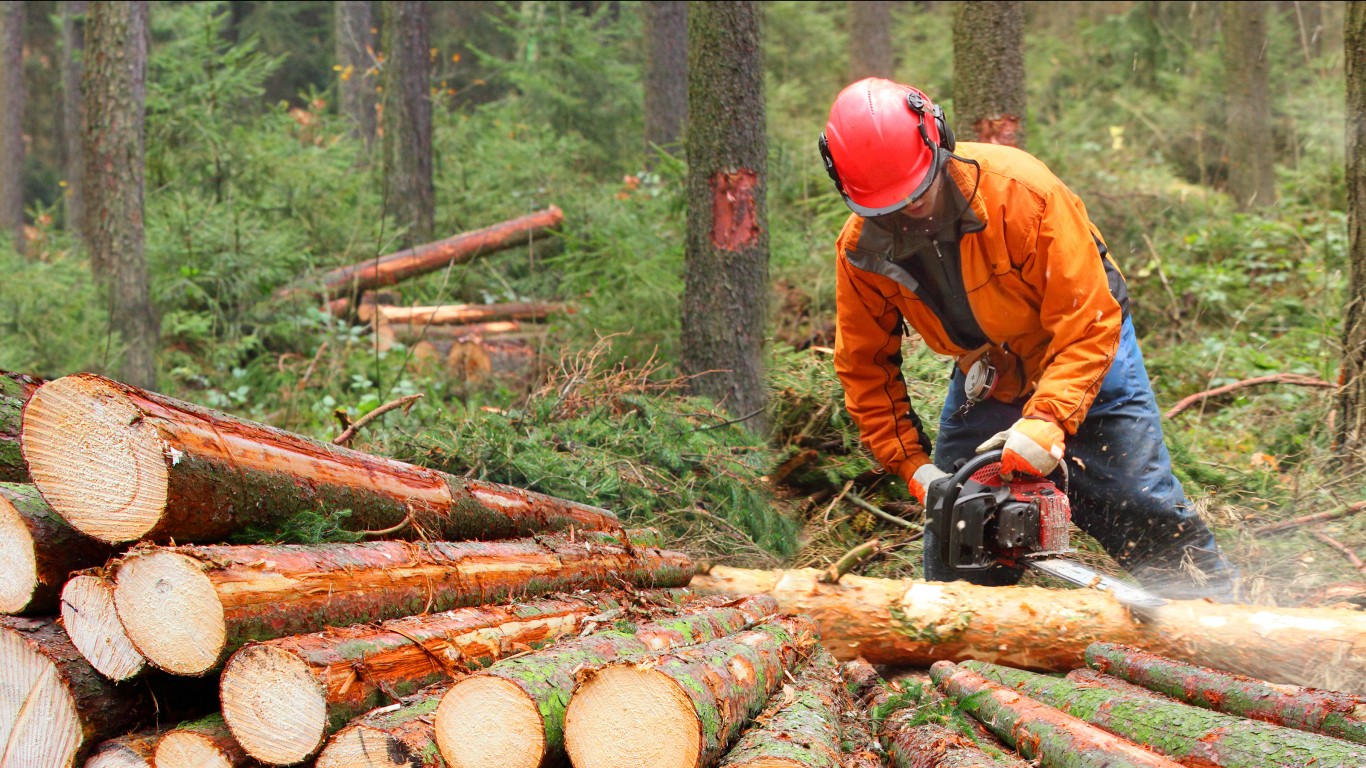
11. First-line supervisors of farming, fishing, and forestry workers
> Fatal work injury rate (2021): 30.0 per 100,000
> Fatal work injuries (2021): 16
> Common cause of fatal injury: Transportation incidents
> Non-fatal injuries (2020): 460 (863.0 per 100,000)
> Total employed (2021): 53,300
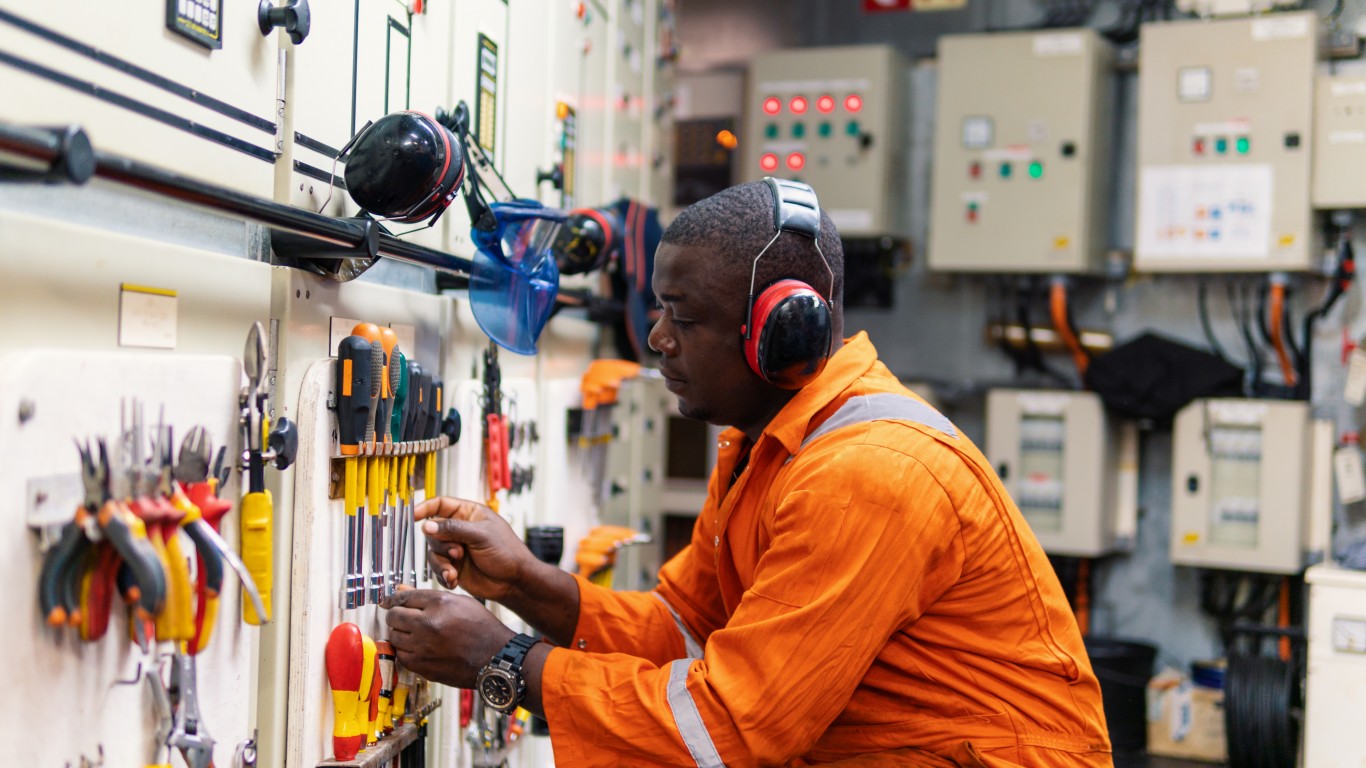
10. Sailors and marine oilers
> Fatal work injury rate (2021): 36.2 per 100,000
> Fatal work injuries (2021): 10
> Common cause of fatal injury: Transportation incidents
> Non-fatal injuries (2020): 380 (1,376.8 per 100,000)
> Total employed (2021): 27,600
[in-text-ad-2]

9. Athletes and sports competitors
> Fatal work injury rate (2021): 38.0 per 100,000
> Fatal work injuries (2021): 6
> Common cause of fatal injury: Sudden cardiac death
> Non-fatal injuries (2020): 920 (5,822.8 per 100,000)
> Total employed (2021): 15,800

8. Heavy and tractor-trailer truck drivers
> Fatal work injury rate (2021): 41.7 per 100,000
> Fatal work injuries (2021): 874
> Common cause of fatal injury: Transportation incidents
> Non-fatal injuries (2020): 43,500 (2,076.7 per 100,000)
> Total employed (2021): 2,094,700
[in-text-ad]
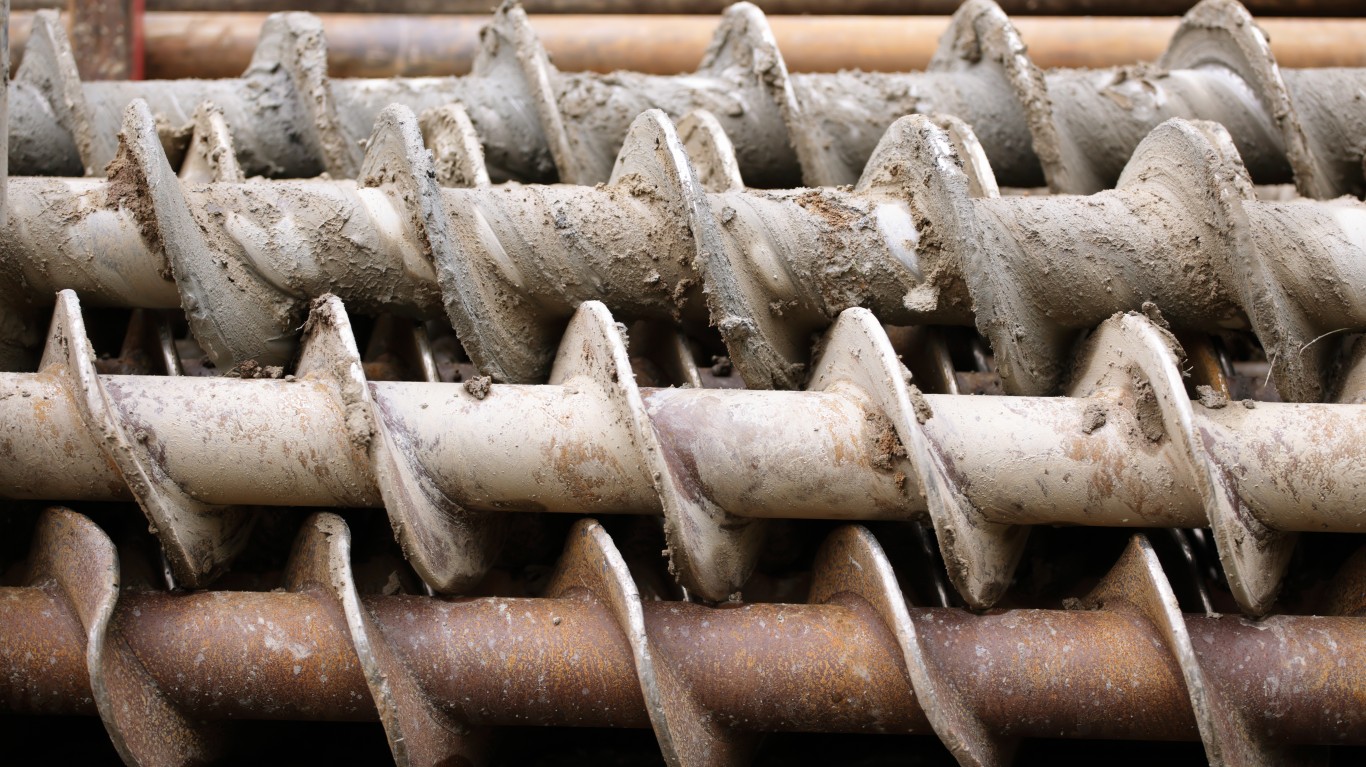
7. Earth drillers, except oil and gas
> Fatal work injury rate (2021): 42.9 per 100,000
> Fatal work injuries (2021): 7
> Common cause of fatal injury: Contact with objects and equipment
> Non-fatal injuries (2020): 240 (1,472.4 per 100,000)
> Total employed (2021): 16,300

6. Roofers
> Fatal work injury rate (2021): 72.4 per 100,000
> Fatal work injuries (2021): 115
> Common cause of fatal injury: Falls, slips, trips
> Non-fatal injuries (2020): 1,960 (1,234.3 per 100,000)
> Total employed (2021): 158,800
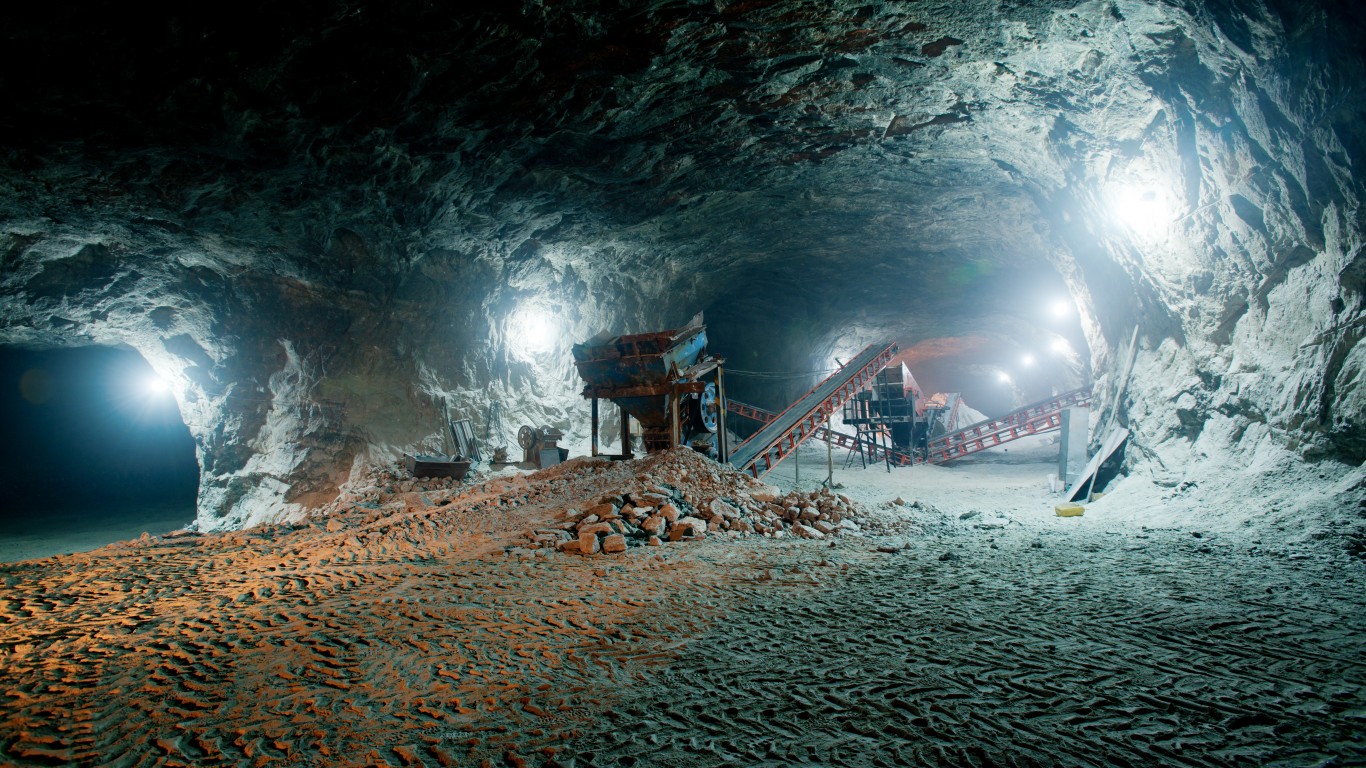
5. Extraction worker helpers
> Fatal work injury rate (2021): 80.6 per 100,000
> Fatal work injuries (2021): 5
> Common cause of fatal injury: Transportation incidents
> Non-fatal injuries (2020): 20 (322.6 per 100,000)
> Total employed (2021): 6,200
[in-text-ad-2]
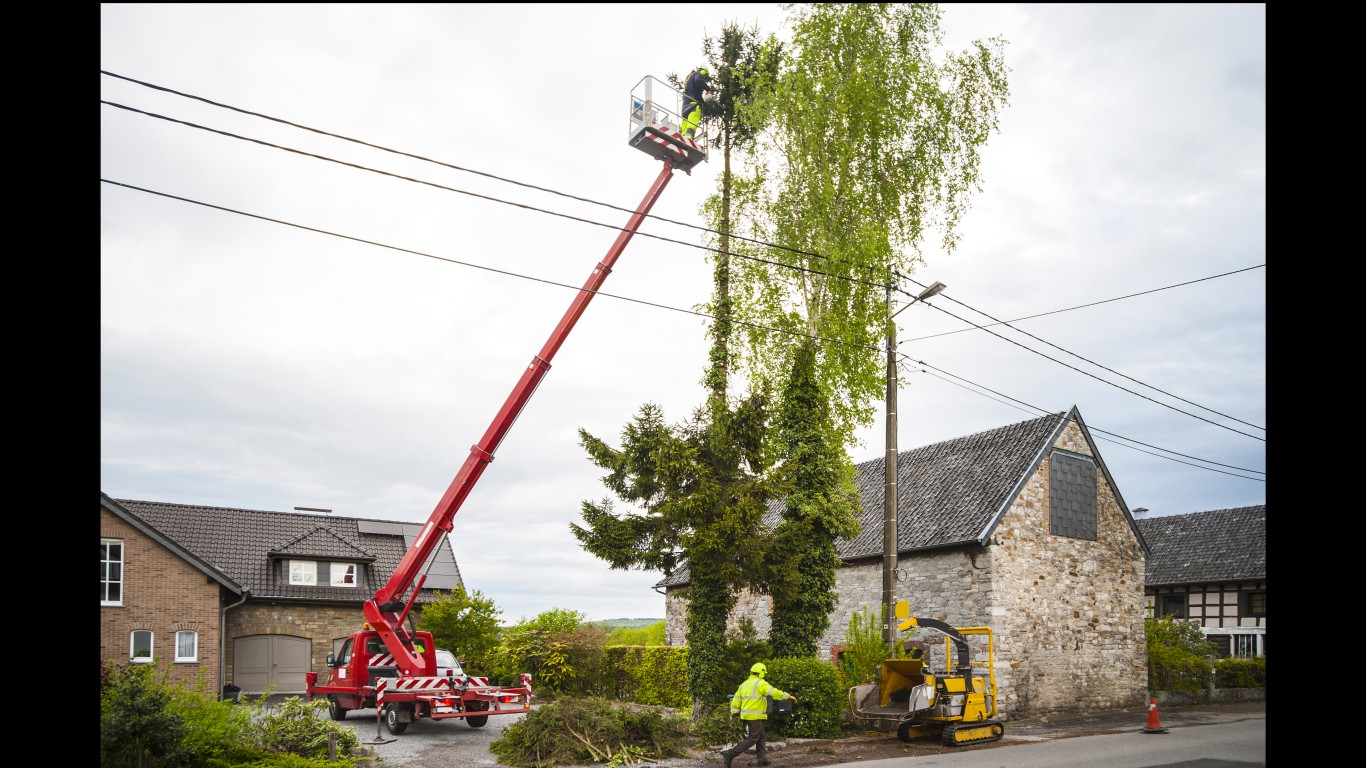
4. Tree trimmers and pruners
> Fatal work injury rate (2021): 122.4 per 100,000
> Fatal work injuries (2021): 78
> Common cause of fatal injury: Falls, slips, trips
> Non-fatal injuries (2020): 840 (1,318.7 per 100,000)
> Total employed (2021): 63,700

3. Commercial pilots
> Fatal work injury rate (2021): 123.7 per 100,000
> Fatal work injuries (2021): 59
> Common cause of fatal injury: Crashes
> Non-fatal injuries (2020): 190 (398.3 per 100,000)
> Total employed (2021): 47,700
[in-text-ad]

2. Commercial divers
> Fatal work injury rate (2021): 233.3 per 100,000
> Fatal work injuries (2021): 7
> Common cause of fatal injury: Equipment failure
> Non-fatal injuries (2020): N/A
> Total employed (2021): 3,000

1. Fallers
> Fatal work injury rate (2021): 589.3 per 100,000
> Fatal work injuries (2021): 33
> Common cause of fatal injury: Contact with machine or object (such as a log)
> Non-fatal injuries (2020): 40 (714.3 per 100,000)
> Total employed (2021): 5,600
Methodology
To determine the most dangerous jobs in the US, 24/7 Wall St. referenced the 2021 Census of Fatal Occupational Injuries from the Bureau of Labor Statistics. Occupations are ranked according to the most annual fatal injuries per 100,000 workers. Employment data used to calculate fatalities and injuries per worker came from the BLS Employment Projections program for 2021. Non-fatal injury data from the BLS Survey of Non-fatal Occupational Injuries and Illnesses from 2020.
We excluded broad-categories of occupations to avoid double counting fatalities. For example, we included commercial airline pilots on this list of most dangerous jobs, but we excluded the broader category of airline pilots and flight engineers. Occupations with fewer than five reported fatalities in 2021 were excluded.
Information about common causes of injury also came from the Census of Fatal Occupational Injuries report. The reported injuries are often only for a fraction of the total number of fatalities, and so the cause listed may not necessarily be the most common cause of 2021 deaths. In cases where causes of death were not reported to the BLS, such as with commercial pilots, fallers, and commercial divers, athletes and sports competitors, wellhead pumpers, taxi drivers, elevator and escalator installers and repairers, we conducted independent research. A clear common cause of death for audiovisual equipment installers and repairers could not be determined.
The Average American Is Losing Their Savings Every Day (Sponsor)
If you’re like many Americans and keep your money ‘safe’ in a checking or savings account, think again. The average yield on a savings account is a paltry .4% today, and inflation is much higher. Checking accounts are even worse.
Every day you don’t move to a high-yield savings account that beats inflation, you lose more and more value.
But there is good news. To win qualified customers, some accounts are paying 9-10x this national average. That’s an incredible way to keep your money safe, and get paid at the same time. Our top pick for high yield savings accounts includes other one time cash bonuses, and is FDIC insured.
Click here to see how much more you could be earning on your savings today. It takes just a few minutes and your money could be working for you.
Thank you for reading! Have some feedback for us?
Contact the 24/7 Wall St. editorial team.
 24/7 Wall St.
24/7 Wall St.
 24/7 Wall St.
24/7 Wall St. 24/7 Wall St.
24/7 Wall St. 24/7 Wall St.
24/7 Wall St.

